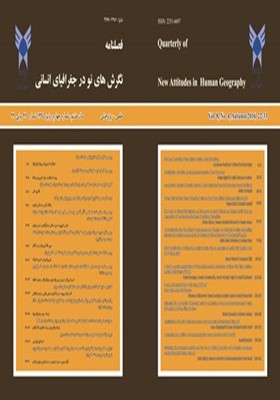تحلیل تطبیقی احساس امنیت در قلمروهای مرزی (نمونهی موردی؛ کردستان ایران و کردستان عراق)
محورهای موضوعی : کالبدی
1 - استادیار جغرافیای سیاسی، دانشگاه خوارزمی تهران
کلید واژه:
چکیده مقاله :
چکیده هدف مقاله ی حاضر بررسی ابعاد ذهنی امنیت و تاثیر آن بر مکان است. رسمیت کردستان عراق از یک منطقه ی خودمختار به یک کشور-ملت، موضوعی است که می تواند سویههای مختلفی بر امنیت ایران داشته باشد. به نظر می رسد که با توجه به پیوستگی ژئوپلیتیکی و فضایی اقلیت های مذهبی و قومیکردستان عراق در درون فضای سرزمینی ایران، رسمیت یافتن منطقه ی خودمختار کردستان عراق به یک کشور-ملت، تبعاتی خواهد داشت که با توجه به وضعیت فعلی ایران، پیامدهای منفی آن بیشتر از پیامدهای مثبت خواهد بود. برای سنجش تبعات رسمیت یافتن کردستان عراق به یک کشور مستقل، پژوهش حاضر به بررسی احساس امنیت در مرز کردستان ایران و کردستان عراق پرداخته است. بر پایه ی نتایج این تحقیق، وضعیت اقتصادی به عنوان نخستین عامل در ناپایداری وضعیت امنیت در کردستان ایران شناسایی شده است و پیوستگی ژئوپلیتیکی قومیت به عنوان دومین عامل در تولید احساس امنیت ناپایدار در کردستان ایران نقش داشته است. بنابراین، مقایسه ی ذهنی که مرزنشینان در دو سوی مرز انجام می دهند، به عنوان یک شاخص تهدیدآفرین در رسمیت کردستان عراق به عنوان یک کشور مستقل، شناسایی شده است.
References
Akhbari, M. and Nami, M.H. (2009). Geography of Border with emphasizing on Iran, Tehran: Geographical Institution of Military Forces [In Persian].
Amanat, H. (2009). “Social Security and its Measurement Pattern”, Journal of Social Security Studies, No. 27, PP. 145-175 [In Persian].
Andalib, A. (2001). Fundamental Theory and Foundations of the Spatial Management of the Borders of I.R.I., Tehran: Publishing of War University [In Persian].
Behforuz, F. (2000). Fundamental Themes in Human Geography, Tehran: University of Tehran [In Persian].
Boggs, S., (2009). International Boundaries: a Study of Boundary Function and Problems. New York, Columbia University Press, second edition.
Cunningham, H. (2002). “Transnational Social Movements and Sovereignties in Transition: Charting New Interfaces of Power at the US-Mexico Border”, Anthropologica, XLIV, pp. 185-196.
GharehBeygi, M., Mottaghi, A. and Rabiei, H. (2014). “Applying of the Spatial Management in Border Organization, Case Study: Border Cities of the Khorasan Jonoubi”, Quarterly bulletin of Greater Khorasan, Vol. 5, No.17, PP. 69-81, [In Persian].
Ghasemi, M.A. (2013). “Religious Democracy and Social Security: Critical Points of the Liberalism and Socialism”, Journal of Strategic Study, No. 64, PP. 65-82, [In Persian].
Hansen, N. (2005). Human Settlement Systems: International Perspectives on Structure, Change and Public Policy, HarperCollins Distribution Services, second edition.
Hawg, P. )2004(. “The historical Process of making non-securitization of security phenomena”, security and globalization, No. 79 and 80, pp. 187-199.
Houtum, H. (2005). “The Geopolitics of Borders and Boundaries”, Geopolitics, No. 10, pp. 672-679.
Jones, P.N., and Wild, T. (1994). “Opening the frontier: recent spatial impacts in the former inner-German border zone, Recent Spatial Impacts in the Former Inner German Border Zone”, Regional Studies, Vol. 28, pp. 259–74.
Karimipour, Y. (2000). New Vision to the Strategic Classification of Borders with emphasizing on Iran, Journal of the faculty of Literature and Human Scinces of University of Tehran, No. 3, PP. 555-568, [In Persian].
Mottaghi, A. (2014). “ Strctural Changes of the Population of I.R.I: Pathology and Measurement of Security Issues”, Journal of Geography, No. 3, Vol. 47, PP. 557-575, [In Persian].
Mottaghi, A. and GharehBeygi, M. (2013). “Studying of the Heterogeneity in Spatial Organization of the Iran’s West Border by using of MCDM”, National Conference of Border, Sustainable Security and Investment chances, Moghan Azad University, [In Persian].
Mottaghi, M., Rabiee, H. and GharehBeygi, M. (2015). Spatial Analysis of the Development in East Borders of Iran, Journal of Economy of Space and Rural Development, No. 4, Vol. 4, PP. 147-167, [In Persian].
Navidnia, M. (2014). “Sociology of Security”, Predicate Journal of the Iranian Association of Sociology, Vol. 57, PP. 2-6, [In Persian].
Newman, D. (2015). “The lines that continue to separate us: Borders in our borderless world”, Progress in Human Geography, Vol. 30 (2), pp. 1–19.
Newman, D. and Paasi, A. (2011). “Fences and neighbors in the post-modern world: boundary narratives in political geography”, Progress in Human Geography, 22 (2), PP. 186–207
Perkmann, M. (2014). “Building governance institutions across European borders”, Regional Studies, Vol. 33, pp. 657–667
Ranjbar, M. (2005). “The Concept of Security in Middle Age Thoughts”, Journal of Strategic Studies, No. 1, Vol. 9, PP. 78-93, [In Persian].
Rashnow, N. (2013). “Comparative Study of the Concept of Security in Recent Security Schools”, Journal of Strategic Studies, No. 66, PP. 7-30, [In Persian].
Robinson, E.H. (2012). “Re-examining Fiat, Bona Fide and Force Dynamic Boundaries for Geopolitical Entities and their Placement in DOLCE”, Applied Ontology, Vol. 7, pp. 93–108.
Rutz, A. (2014). “Grenzen im Raum – Grenzen in der Geschichte. Probleme und Perspektiven. In: Eva Geulen, Stephan Kraft (Hrsg.): Grenzen im Raum – Grenzen in der Literatur”. In: Zeitschrift für deutsche Philologie, Sonderheft zum Band 129, Berlin, PP. 7–32.
Sabaghain. A. (2012). “Human Security and Comprehensive Defense”, Journal of Strategic Studies, No. 62, PP. 89-118, [In Persian].
Shakouei, H. (2004). New Trends in Philosophy of Geography, Vol. 2: Environmental Philosophies and Geographical Schools, Tehran: Gitashenasi Publisher.


